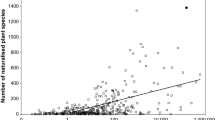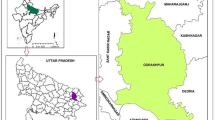Abstract
Different forms of management of wild, weedy, and domesticated plants carried out by the Nahua and the Mixtec in the Balsas River Basin, Mexico, are described. Along with cultivation of domesticated plants, these forms of plant management include gathering from wild populations; in situtolerance of plant individuals during clearings of natural vegetation; in situenhancement and protection of particular plants among populations of some species; as well as sowing or planting of propagules and transplantation of complete individuals of weedy and wild plants in controlled ex situenvironments. Processes of artificial selection and possible routes of domestication occurring in these forms of plant management are discussed.
Similar content being viewed by others
References
Alcorn, J. B. (1981). Huastec noncrop resource management: Implications for prehistoric rain forest management.Human Ecology 9(4): 395–417.
Bye, R. A., Jr. (1981). Quelites-ethnoecology of edible greens—past, present and future.Journal of Ethnobiology 1: 109–123.
Bye, R. A., Jr. (1985). Botanical perspectives of Ethnobotany of the greater southwest.Economic Botany 39(4): 375–386.
Bye, R. A., Jr. (1993). The role of humans in the diversification of plants in Mexico. In Rammamoorty, T. P., Bye, R., Lot, A., and Fa, J. (eds.),Biological Diversity of Mexico. Oxford University Press, New York, Oxford, pp. 707–731.
Caballero, J. (1984). Recursos comestibles potenciales. In Reyna, T. T. (ed.),Seminario Sobre la Alimentación en México. Instituto de Geografia, Universidad Nacional Autónoma de México, México, pp. 114–125.
Caballero, J. (1994). La dimension culturelle de la diversité végétale au Mexique.Journal d'Agriculture Traditionelle et de Botanique Appliqué, Nouvelle Série 36(2): 145–158.
Caballero, J., and Mapes, C. (1985). Gathering and subsistence patterns among the P'urhepecha Indians of Mexico.Journal of Ethnobiology 5(1): 31–47.
Casas, A. (1992). Etnobotánica y Procesos de Domesticación enLeucaena Esculenta (Moc. et Sessé ex A. DC.) Benth. MSc. dissertation, Facultad de Ciencias, Universidad Nacional Autónoma de México, México, 233 p.
Casas, A., and Caballero, J. (in press). Traditional management and morphological variation in Leucaena esculenta (Moc. et Sessé ex A. DC.) Benth. (Leguminosae: Mimosoideae) in the Mixtec region of Guerrero, Mexico.Economic Botany.
Casas, A., Viveros, J. L., Katz, E., and Caballero, Y. J. (1987). Las plantas en la alimentación mixteca: Una aproximación etnobotánica.América Indigena 47(2): 317–343.
Casas, A., Viveros, J. L., and Caballero, J. (1994).Etnobotanica Mixteca: Sociedad, Cultura y Recursos Naturales en la Montana de Guerrero. Instituto Nacional Indigenista-Consejo Nacional Para la Cultura y las Artes, Mexico, 366 p.
Colunga, P., Hernández-X., E. Castillo, A. (1986). Variación morfológica, manejo agrícola y grado de domesticación deOpuntia spp. en el Bajio Guanajuatense.Agrociencia 65: 7–49.
Davis, T., and Bye, R. A. (1982). Ethnobotany and progressive domestication ofJaltomata (Solanaceae) in Mexico and Central America.Economic Botany 36(2): 225–241.
De Wet, J. M. J. (1992). The three phases of cereal domestication. In Capman, G. P. (ed.),Grass Evolution and Domestication. Cambridge University Press, Cambridge, pp. 176–198.
De Wet, J. M. J., and Harlan, J. R. (1975). Weeds and domesticates: Evolution in the man-made habitat.Economic Botany 29(2): 99–107.
Groube, L. (1989). The taming of the rain forest: A model for late Pleistocene forest exploitation in New Guinea. In Harris, D. R., and Hillman, G. C. (eds.),Foraging and Farming. The Evolution of Plant Exploitation. Unwin Hyman, London, pp. 292–304.
Hallam, S. J. (1989). Plant usage and management in southwest Australian aboriginal societies. In Harris, D. R., and Hillman, G. C. (eds.),Foraging and Farming. The Evolution of Plant Exploitation. Unwin Hyman, London, pp. 136–151.
Harlan, J. R. (1975).Crops and Man. American Society of Agronomy, Madison, Wisconsin, 295 p.
Harlan, J. R. (1992). Origins and processes of domestication. In Chapman, G. P. (ed.),Grass Evolution and Domestication. Cambridge University Press, Cambridge, pp. 159–175.
Hawkes, J. G. (1983).The Diversity of Crop Plants. Harvard University Press, London, 184 p.
Hernández-X., E., and Ramos, A. (1977). Metodología para el estudio de agroecosistemas con persistencia de tecnología agrícola tradicional. In Hernández-X., E. (ed.),Agroecosistemas de México. Colegio de Postgraduados, Chapingo, México, pp. 321–333.
Hillman, G. C. (1989). Late palaeolithic plant foods from Wadi Kubbaniya in upper Egypt: Dietary diversity, infant weaning, and seasonality in a riverine environment. In Harris, D. R., and Hillman, G. C. (eds.),Foraging and Farming. The Evolution of Plant Exploitation. Unwin Hyman, London, pp. 207–239.
Pearsall, D. M. (1989). Adaptation of prehistoric hunter gatherers to the high Andes: The changing role of plant resources. In Harris, D. R., and Hillman, G. C. (eds.),Foraging and Farming. The Evolution of Plant Exploitation. Unwin Hyman, London, pp. 318–334.
Rzedowski, J. (1978).Vegetación de México. Limusa, México, 432 p.
Schneider, T. C. (1972). A Land Management System Used by the Mesolithic Communities of Southern England. Masters thesis, Anthropology Department, Pennsylvania State University, Pennsylvania.
Schwanitz, F. (1967).The Origin of Cultivated Plants. Harvard University Press, Cambridge, Massachusetts, 175 p.
Shipek, F. C. (1989). An example of intensive plant husbandry: The Kumeyaay of southern California. In Harris, D. E., and Hillman, G. C. (eds.),Foraging and Farming. The Evolution of Plant Exploitation. Unwin Hyman, London, pp. 159–170.
Steward, J. (1938). Basin Plateau Aboriginal Socio-political Groups. Bureau of American Ethnology, Bulletin 12.
Toledo, V. M. (1988). La diversidad biológica de México.Ciencia y Desarrollo 8(14): 17–30.
Vavilov, N. I. (1926). Studies on the origin of cultivated plants.Bulletin of Applied Botany, Genetics and Plant Breeding 16: 139–248.
Vázquez, R. M. C. (1986). El Uso de Plantas Silvestres y Semicultivadas en la Alimentación Tradicional en Dos Comunidades Campesinas del Sur de Puebla. BSc. dissertation, Facultad de Ciencias, Universidad Nacional Autónoma de México, México, 104 p.
Vázquez, R. M. C. (1991). Tendencias en el proceso de domesticación del papaloquelite (Porophyllum ruderale (Jacq.) Cass. subsp.macrocephalum (DC.) R. R. Johnson ASTERACEAE). MSc. dissertation, Facultad de Ciencias, Universidad Nacional Autónoma de México, México, 153 p.
Viveros, J. L., Casas, A., and Caballero, J. (1993). Las plantas comestibles y la alimentación entre los mixtecos guerrerenses. In Leff, E., and Carabias, J. (eds.),La Dimensión Cultural del Desarrollo Sustenable. Centro de Investigaciones Interdisciplinarias en Humanidades, Universidad Nacional Autónoma de México-Editorial Porrúa, México, pp. 625–670.
Williams, D. E. (1985). Tres Arvenses Solanáceas Comestibles y Su Proceso de Domesticación en el Estado de Tlaxcala, México. MSc. dissertation, Colegio de Postgraduados, Chapingo, México, 173 p.
Zizumbo, V. D., and Colunga, P. (1982).Los Huaves: La Apropiación de los Recursos Naturales. Departamento de Sociología Rural, Universidad Autónoma de Chapingo, Chapingo, México, 277 p.
Author information
Authors and Affiliations
Rights and permissions
About this article
Cite this article
Casas, A., Vázquez, M.d.C., Viveros, J.L. et al. Plant management among the Nahua and the Mixtec in the Balsas River Basin, Mexico: An ethnobotanical approach to the study of plant domestication. Hum Ecol 24, 455–478 (1996). https://doi.org/10.1007/BF02168862
Issue Date:
DOI: https://doi.org/10.1007/BF02168862




